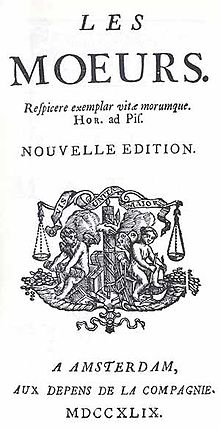François-Vincent Toussaint

François-Vincent Toussaint (21 December 1715 - 22 June 1772) was a French writer most famous for (The Manners). The book was published in 1748 and banned the same year;[1] it was prosecuted and burned by the French court of justice.
Toussaint worked with Denis Diderot and Marc-Antoine Eidous on a French translation of Dr. Robert James' (the London publication of 1743-1745, fol. 3 vols, became Dictionnaire universel de medicine, published in Paris 1746-1748, fol. 6 vols). He later contributed to the first volumes of the Encyclopédie of Jean le Rond d'Alembert and Diderot.[2]
Toussaint produced novels, and also worked as a proof reader, magazine publisher and language translator. He translated Tobias Smollett's The Adventures of Peregrine Pickle, and composed the table of contents for a 1749 edition of L'Esprit des Lois (The Spirit of the Laws) by Charles de Secondat, Baron de Montesquieu.
Toussaint was born in Paris and studied to become a lawyer, but he always worked in the book trade. He was fortunate when his novel was issued, because he was acquainted with the minister of the Navy, Maurepas. The book was a scandal (and a huge success, reprinted 13 times in the first year) for several reasons, including the fact that one of the treatise's characters was assumed to be based on the oversanctimonious queen Marie Leszczynska. Parisian reader Edmond-Jean-François Barbier wrote in his diary that Les Moeurs had been banned and he would now have to pay double the normal price for the book.[3]
Toussaint finally got into trouble because of his book in 1757, during the period when Robert Damiens attempted to assassinate Louis XV of France. On the other hand, Claude Adrien Helvétius legally published his book in 1758. It was then that the enemies of the Enlightenment saw their chance to destroy the hated Encyclopédists. This was the moment when Les Mœurs came to be regarded as a book that could lead to regicide. Also Toussaint illegally sold 400 exemplaires of an illegal reprint of . He left France then, traveling first to Brussels, and in 1764 moved to Berlin. He had become an external member of the Prussian Academy of Science in 1751, but once he was settled in Berlin he was appointed a regular member of the Academy.
Toussaint published an Éclaircissement (Explanation) of his book Les Mœurs in 1763, in which he showed that every one was mistaken and the book was not at all offensive. During this time he also worked as a teacher in a military school recently founded by Frederick II of Prussia.
When he died in 1772, he was quite poor, leaving behind a wife and several children.
As for Les Mœurs, even if it were his biggest success, he felt sorry for having written it almost all his life. Parts of the book were re-used in several articles of the Encyclopédie.
Literature[]
A short summary is to be found in
- The Encyclopedists as individuals: a biographical dictionary of the authors of the Encyclopédie by Frank A. Kafker and Serena L. Kafker. Published 1988 in the Studies of Voltaire and the Eighteenth century. ISBN 0-7294-0368-8
It is basically an excerpt of a more extended discussion, the unpublished thesis of
- Margaret Elinor Adams: François Vincent Toussaint: Life and Works. Dissertation, Boston University Graduate School 1966
Adams corrects several flaws and errors in previous research on Toussaint by
- Toussaint, François-Vincent: Anecdotes curieuses de la cour de France sous la régne de Louis XV. Texte original publié pour la première fois avec une notice et des annotations par Paul Fould. Paris: Plon 1905
References[]
- ^ Lyons, Martyn (2011). Books: A Living History. London: Thames & Hudson. p. 102. ISBN 978-0-500-29115-3.
- ^ Kafker, Frank A.: Notices sur les auteurs des 17 volumes de « discours » de l'Encyclopédie (suite et fin). Recherches sur Diderot et sur l'Encyclopédie Année (1990) Volume 8 Numéro 8 p. 117
- ^ Lyons, Martyn (2011). Books a Living History. Los Angeles: J. Paul Getty Museum. p. 103. ISBN 978-1-60606-083-4.
External links[]
- Works by or about François-Vincent Toussaint at Internet Archive
- For a bibliography of Les Mœurs see https://web.archive.org/web/20111005221725/http://www.encore.at/mam/toussaint/lesmoeurs
- For an unpublished letter see http://www.encore.at/mam/toussaint
- For his speeches at the Prussian Academy see http://www.bbaw.de/bibliothek/digital/index.html
- A summary in German and a picture of a titlepage of Les Mœurs to be found at http://ub-dok.uni-trier.de/argens/pic/pers/Toussaint.php
- 1715 births
- 1772 deaths
- Writers from Paris
- 18th-century French writers
- 18th-century French male writers
- Contributors to the Encyclopédie (1751–1772)
- French translators
- 18th-century translators